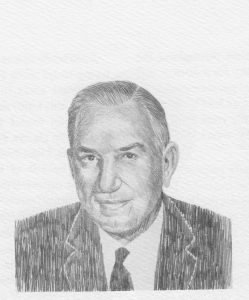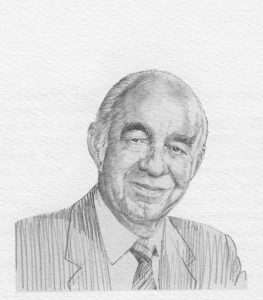The story of the life of Winton Malcom Blount, Jr. Chairman of the Board and CEO of Blount, Inc., Montgomery, Alabama, is the story of a man dreaming about what could be and working hard to turn his dreams into realities. It is the story of a man who contributes to others, and to society as a whole, through his individual and corporate efforts.
Born February 1, 1921, in Union Springs, Alabama, Winton Malcolm Blount was the oldest of the two sons of Clara Belle (Chalker) and Wynton M. Blount. “Red;’ as he was nicknamed, was educated in the Union Springs Public Schools before entering the University of Alabama in 1939. In early 1942, he joined the Army Air Force and served as a B-29 pilot until his discharge in 1945.
When he and his brother Houston (who had served in the Navy Air Corps) returned to Union Springs, they found that their father’s sand and gravel business had deteriorated after his death in 1944. Having grown up in the entrepreneurial tradition, they set about to rebuild the business. With modest funds, they purchased some Army surplus equipment in Atlanta for use in the sand and gravel business. The direction of their business changed a few weeks later when “Red” returned from a trip to Atlanta with four surplus, but brand-new, D-7 Caterpillar tractors and scrapers. When Houston asked what they were going to do with “that stuff;’ “Red” replied, ‘We’re going in the contracting business:’
Their first contracts were for building fishponds around Union Springs. In the summer of 1946, they won a contract for grading and base sub-contract work on several Alabama Highway Department jobs. Although they didn’t know much about building highways, “Red” Blount has since said, they knew how to work. Through the late 40s, they continued to build roads (and bridges) in Alabama and Mississippi.
Blount Brothers Corporation was incorporated on September 13, 1949, and based in Tuskegee, Alabama, with “Red” Blount as president and chairman of the board. In that same year, the company won its first $1 million dollar contract, to build the superstructure for the First Avenue Viaduct in Birmingham. When the young men learned that their bid was $124,000 under the next lowest bid, they were horrified. Their friends told them they would “lose their shirts;’ but they didn’t. The job was completed several months ahead of schedule.
The incentive for fast and quality work on that first large job was a Thanksgiving turkey for each crew member of the team that finished first. Incentives in Blount, Inc. today include bonus plans, a profit-sharing plan, and pension program, and complete benefit programs of all kinds.
Blount Brothers Corporation moved to Montgomery in 1950. In 1952, the Corporation won a contract to build part of a complex wind tunnel facility at Tullahoma, Tennessee. The successful completion of this challenging project helped shape the Blount business strategy of focusing on big, complicated, fixed-price construction projects-often first of a kind-where the profit margins reflected the risks.
In the late 40s, much to “Red” Blount’s regret, Houston Blount, currently chairman of the board of Vulcan Materials Co. in Birmingham, left the corporation to pursue his interest in the materials business. Houston Blount still has remained a member of the Blount board and “Red’s” valuable counselor.
“Red” Blount has always been a risk-taking, entrepreneurial, creative type of manager who focuses on long-term benefits, not on short-term earnings. He has stressed that the success of a company depends on its people, on its strategy for growth, and on its modem management techniques.
Among the many complex projects that the company has completed throughout the world are an atomic energy installation at Oak Ridge, Tennessee-the first atomic plant ever built on a fixed-price basis; the nation’s first Intercontinental Missile Base for the Atlas; the launch complexes for the Mercury, Gemini, and Apollo space programs; the Louisiana Superdome-the world’s largest indoor arena; and an academic center for King Saud University in Riyadh, Saudi Arabia.
In 1969, when “Red” Blount became Postmaster General of the U.S., he placed his company stock in a blind trust and determined that the company should not bid on any government contract while he was a government official and for more than a year following his departure. This self-imposed restriction forced the interim management to expand more aggressively into industrial construction and to acquire manufacturing companies for diversification. That diversification continued after “Red” Blount returned as chairman and CEO in 1974.
Today, the company (incorporated as Blount, Inc. in 1971) is an international manufacturing and construction corporation. The corporation and its subsidiaries employ approximately 8,100 people at offices, plants, and job sites throughout the U.S. and in several other countries.
Almost forty years ago, “Red” Blount wrote down precepts he believed necessary for the success of a company and of an individual. One of the precepts for individual success stated in The Blount Philosophy (a copy of which every new employee receives) is “participation in civic, cultural, religious, and political affairs of our country:’
The Blount Philosophy asks nothing of others that “Red” Blount has not done himself.
For example, a selected list of only his current activities includes: President pro tempo re of the Board of Trustees of The University of Alabama; Chairman of the Board of Trustees of Rhodes College; a director of Alabama Shakespeare Festival and of Folger Shakespeare Library; Director and past Chairman of the National Business Committee for the Arts; a trustee of Alabama Trust Fund Board; a board member of Friends of American Art in Religion and the American Enterprise Institute. “Red” Blount has also been actively involved in politics as exemplified by his heading several campaigns in the South for Republican presidential candidates, and by his serving as a delegate to the 1988 Republican Convention in New Orleans.
As stated earlier, he served as Postmaster General of the United States and also as a member of President Nixon’s cabinet. He is credited with “taking politics out of the postal service” because of his strong “lobbying” for the legislation that created the U. S. Postal Service, a non-political organization of which he was chairman of the board in 1970-71. In 1972, “Red” Blount ran unsuccessfully for a seat in the U. S. Senate. He considers his defeat the best thing that could have happened to him because he wouldn’t have been happy in the senate. “I’m not a compromiser; I’m a manager. I like to accomplish things:’
“Red” Blount has become a staunch advocate of corporate as well as individual support of the arts.
The Blount Collection of American Art is one of the most extensive and highest quality corporate collections in the world. The paintings in the collection (all of which he has personally selected) are periodically rotated on the walls of the corporate offices and are made available to the public through tours and loans to museums throughout the world.
“Red” Blount built and gave to the State the $21.5 million dollar Carolyn Blount Theatre, home of the Alabama Shakespeare Festival complex and the 200 acres (called the Wynton M. Blount Cultural Park) on which it and the new Montgomery Museum of Fine Arts are built. A gift to the museum of $500,000 from the Blount Foundation and 41 paintings (valued at $15 million) from the Blount Collection of American Art accompanied the gift of the land on which it is built.
It is impossible to list all the awards and honors given to Winton Malcolm “Red” Blount. Suffice it to say, this native Alabamian who thinks big, builds bigger, and gets things done, stands tall in many peoples’ eyes. He is a great American.
Sources of bibliographic information: Blount, Inc. publications: ‘The Blount Story: American Enterprise at Its Best;’ address given by Winton M. Blount, to the Newcomen Society in North America, Birmingham, Oct. 10, 1979; Greater Minneapolis Chamber of Commerce, Catalyst, 1986; The Montgomery Advertiser and The Alabama Journal, Dec. 27, 1987; The New York Times, May 10, 1981; “Winton “Red” Blount,” Arts & Antiques, May, 1986.




